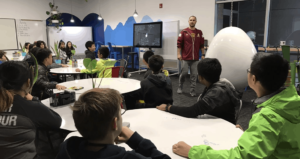The need for edu-innovation
The US won’t spend or reform its way to high and equitable educational attainment. The basic model of age cohorts slogging through print-based content with ability tracking (with equates to race and income tracking) is obsolete, expensive and unjust.
Young people in emerging and developing economies (which includes a portion of urban America) often lack access to high quality affordable secondary education that connects them to college and careers. This global secondary education gap is or will impact the lives of one billion students worldwide.
The confluence of nearly ubiquitous broadband, cheap access devices and powerful application development platforms have transformed nearly ever sector of society except learning. The lack of public and private investment in research and development is a function, in the US, of a locally controlled inefficient public delivery system. We now have the potential for students worldwide to learn more, faster, and cheaper. And innovation is the key.
Specific problems that innovation will address include:
· Teacher gap: Increasing graduation requirements are exacerbating the shortage of highly qualified math and science teachers. Engaging content and distance learning have the potential to meet increasing global demand.
· Personalization: mass customization technology in entertainment, health, and business suggest that learning productivity can be improved through adaptive technology—the ability to diagnosis and create learning experiences tailored to a students skill and interest. Educational research suggests that we should attempt to teach students at their instructional level and we continue to do this with one teacher and 25 students in a classroom. We won’t dramatically change learning productivity until we dramatically personalize learning.
· Motivation: some families, neighborhoods (and nations) lack the strong cultural press that encourages some students to endure challenging (and boring) content. A sophisticated approach to determining learning styles and motivational attributes has the potential to improve persistence and achievement.
· Special needs: while the US spends more than a fifth of its education budget on special needs populations, we don’t actually have very effective means of diagnosing and treating learning disabilities. New assessment and learning tools have the potential to address these needs in a far more productive way.
In short, innovative learning tools and formats have the potential to help students worldwide gain access to learning and, as a result, a productive life.
Governments and foundations are likely to approach this challenge by trying to improve system components. It’s like replacing a fuel pump on a ’57 Chevy—it will run better, but it’s not what you need. This is a design problem. The challenge is inventing (and investing in) the future of learning. This is a task for entrepreneurs and the risk takers that support them. We need to create room for them to get to work, reduce some of the barriers, and provide a little support.
Our public school system is GM in the 80s. The question is, what are we going to do about it? Innovation will happen with or without the US public schools. We’re already seeing the development of a new learning ecosystem with Wikipedia, virtual charter schools, peer-to-peer learning sites, adaptive learning games, and online language learning. Do we ride the system we have into bankruptcy or do we innovate? It may be a good question for your superintendent or next governor.







Marc Share
My question would be, where are the progressive intellectual thinkers who can brainstrom ideas to test and try. As a parent of a 'Special Needs' child in the second largest district in the country I am sad to say that LAUSD is woefully lacking in anything close to innovation and accountability and they push the smart kids with learning differences into NPS's where the 'Culture of Discipline' is more important than anything and they use that as justification for abusing the kids. We need bold and innovative leaders who are willing to step to the forefront, we need resources for parents to rally around where there is quick action and support. We need help NOW!